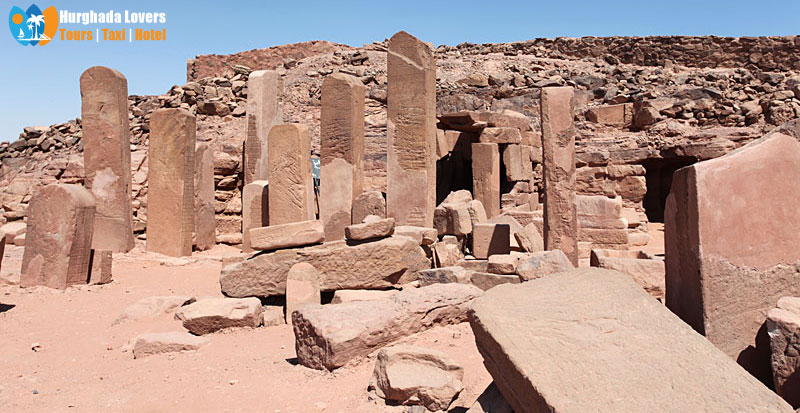Serabit el-Khadim Temple in South Sinai Egypt | Facts & History Pharaonic Temples
History Of Egyptian & the establishment of the most important archaeological Pharaohs temples of the Ancient Egypt civilization.
the secrets of the construction of the Pharaonic temple and the effects and discoveries it contains that revive the Pharaonic civilization and more Things to Do in Egypt.
Hurghada lovers Offer Luxury Hurghada to Luxor Tours | El Gouna to Luxor Tours | Makadi bay to Luxor Tours | Sahl Hasheesh to Luxor Tours | Soma bay to Luxor Tours.
Serabit el-Khadim Temple in South Sinai Egypt
The most important archaeological temples. Tourist places of religious heritage in Egypt. Tourism in South Sinai, where all tourists go for a special visit. What do you see when you enter a temple in Sinai and visit the soldiers’ castle in Sinai?
Serabit El-Khadem Temple is in the southwest of the Sinai Peninsula, next to the city of Abu Zenima in the South Sinai Governorate. It is one of the temples dating back to the Pharaonic era, where ancient mining camps were discovered in this area, in addition to the Temple of Hathor.
Serabit is the name of one of the ancient Egyptian deities, which were used by the pharaohs; To protect the desert, where the road that leads to it is very rugged, and it is on a plateau difficult to reach from all sides.
About the Serabit el-Khadim Temple:
The ruins of the Serabit el-Khadim Temple, as well as the mines that lie above the flat surface of this high plateau. Several statues bearing the names of King Sneferu “Egyptian Pharaohs kings” of the Fourth Dynasty have been found in this area.
Also found in this temple have antiquities belonging to King Monthuhotep III and King Monthuhotep IV of the Eleventh Dynasty, as well as an inscription for Sesostris I and the name of his father Amenemhat I.
Description of the Serabit el-Khadim Temple:
The temple is located on the surface of a sandstone plateau, about 1200 m above sea level. The length of the temple is about 80 meters and its width is about 35 meters. Above the same mountain and near the temple, there are turquoise caves whose rocks are full of many important inscriptions.
To the west of the temple are the workers’ houses, circular in shape, roughly built with the stones of the area. Some of the tools of everyday life have been found there.
The reason for the name:
Archaeologists say that the reason for the name is since the sarbote, which is the singular of sarabit, means, according to the inhabitants of Sinai, the large rock that stands on its own, which is known as monuments, and its singular is a monument. As for the word servant, it is the same in the temple, because there are columns in the temple that look like black-skinned servants.
What do you see when you enter the Serabit el-Khadim Temple?
The temple includes three entrances that the visitor accesses from three different valleys: the main entrance is from Rawd al-Ayr, the second entrance is from Wadi al-Khasif, and the third entrance is from Wadi al-Taliha.
When you enter through the main entrance, you see two scenes, one from the time of King Ramses II and the other from the reign of King Seth Nakht (the first king of the Twentieth Dynasty).
More than one archaeological mission has worked in this area, where a total of 25 inscriptions have been found. Researchers called these signs the Sinaitic alphabet, connecting them to Sinai, the land that witnessed their recording and discovery.
It turned out that these signs were inspired by ancient Egyptian signs, and were influenced by some Semitic writings, given that Sinai was a meeting point for those who came from Asia.
Inscriptions and reliefs of Serabit el-Khadim Temple:
During the twelfth dynasty, it acquired more importance. It is full of inscriptions, monuments and temples belonging to this dynasty. The number of inscriptions in Serabit El-Khadem has reached 378 inscriptions from the Middle and New Kingdom.
The first to care about Serabit El-Khadem was Sesostris I “1972-1928 BC”, one of the kings of the twelfth dynasty. The temple was built there, and during the reign of kings Amenemhat III and Amenemhat IV, the temple of the god “Sebed” carved into the rock and the temple of the goddess “Hathor” were erected in the temple, and the temple of kings outside the temple.
During the reign of dynasty 18, Amenophis I returned to Serabit El-Khadem and continued to take an interest in it during the reigns of King Thutmosis III, Queen Hatshepsut, Amenophis II, Sethi I, Ramses II and Ramses VI.
Temple of Serabit El-Khadem:
It is located on top of a small rectangular mountain north of the city of Al-Tor. It is a structure that contains several caves.
The most important caves:
Cave of the Goddess Hathor: This cave was built during the reign of King Snefru.
Suido Cave: God of War.
Temple Address
The temple of Serabit El-Khadem is accessible via this map.
Opening hours of Serabit El-Khadem Temple
The temple of Serabit El-Khadem can be visited from nine in the morning to five in the evening.
Author & Writer Serabit el-Khadim Temple: Tamer Ahmed Abd elfatah Yousif

